Tourism at the time in the Vans region |

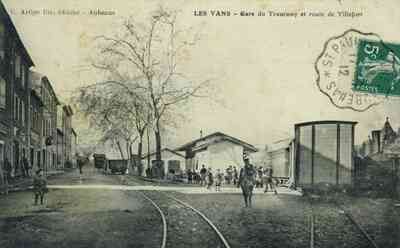 Les Vans (175 m; buses to Alès, Largentière, Aubenas and Vals, to Villefort and Montélimar; Dardaillon Hotel, Léopold-Ollier Square, 14 rooms; Château du Scipionnet, 2 km northeast, 13 rooms; Initiative Union, Ville-Hotel street, phone 31), 1,632 inhabitants, in a small valley opening northeast onto the Chassezac valley. On Léopold-Ollier Square stands a monument to surgeon Ollier, who was one of the first to succeed in joint resections in Lyon. Church with a beautiful carved beech altarpiece. In the hospital garden, a Roman-era gravestone inscription. Lovely walks around along the banks of the Chassezac.
Les Vans (175 m; buses to Alès, Largentière, Aubenas and Vals, to Villefort and Montélimar; Dardaillon Hotel, Léopold-Ollier Square, 14 rooms; Château du Scipionnet, 2 km northeast, 13 rooms; Initiative Union, Ville-Hotel street, phone 31), 1,632 inhabitants, in a small valley opening northeast onto the Chassezac valley. On Léopold-Ollier Square stands a monument to surgeon Ollier, who was one of the first to succeed in joint resections in Lyon. Church with a beautiful carved beech altarpiece. In the hospital garden, a Roman-era gravestone inscription. Lovely walks around along the banks of the Chassezac.
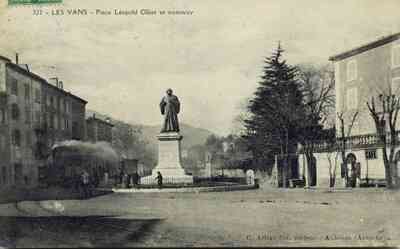 Olivier Wood (2 hours for a brief visit, 4 hours for a detailed tour). The Olivier Wood, crossed by the Chassezac and stretching east from road N. 101, is one of the strangest natural wonders of the Vivarais. An in-depth visit requires about 4 hours on foot and a guide is essential; the guide’s house is on the edge of the forest, in the Mège Valley, 5 km east of Les Vans on N. 101. Tourists with limited time can get a feel for the landscape of Olivier by taking the road that crosses the forest near Mège and offers a beautiful view of the Chassezac gorge at the exit, describing a long stretch around the steep promontory of Casteljau, and exploring nearby on foot (about 20 km round trip).
Olivier Wood (2 hours for a brief visit, 4 hours for a detailed tour). The Olivier Wood, crossed by the Chassezac and stretching east from road N. 101, is one of the strangest natural wonders of the Vivarais. An in-depth visit requires about 4 hours on foot and a guide is essential; the guide’s house is on the edge of the forest, in the Mège Valley, 5 km east of Les Vans on N. 101. Tourists with limited time can get a feel for the landscape of Olivier by taking the road that crosses the forest near Mège and offers a beautiful view of the Chassezac gorge at the exit, describing a long stretch around the steep promontory of Casteljau, and exploring nearby on foot (about 20 km round trip).
It is impossible, through description, to guide tourists through the marvels of Olivier Forest, a gigantic labyrinth of white limestone rocks, with horizontal strata broken in all directions, arranged in circles, terraces, and fantastic architectures. Beautiful vegetation of oaks and mulberry trees shades this vast chaos through which the Chassezac has carved a picturesque canyon. We will only indicate, in the usual order of the visit, the main curiosities of the forest.
From the Mège Valley, you ascend on large limestone slabs towards Saint-Eugène Chapel, built on a large limestone table: a very beautiful view over the Chassezac valley, the basin, and the village of Chassagnes, to the west over the Tanargue mountain range, and far to the east over Mont Ventoux. Opposite, on the other side of the river, rises the Cornillon promontory with ruins of an ancient village; towards the southeast, the Endieu cliff extends on the right bank.
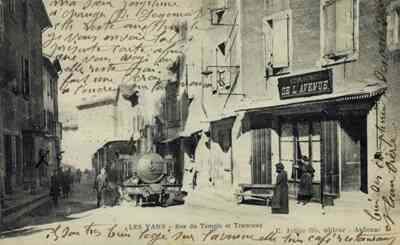 We descend on the right bank of the Chassezac; on the left bank, the Barres Cave. We pass through the narrow fissure of the Gleizasse ravine, then, climbing back onto the wall of the right bank, we reach a wide ledge about a meter deep, winding along the vertical wall and remaining about 30 meters above the Chassezac.
We descend on the right bank of the Chassezac; on the left bank, the Barres Cave. We pass through the narrow fissure of the Gleizasse ravine, then, climbing back onto the wall of the right bank, we reach a wide ledge about a meter deep, winding along the vertical wall and remaining about 30 meters above the Chassezac.
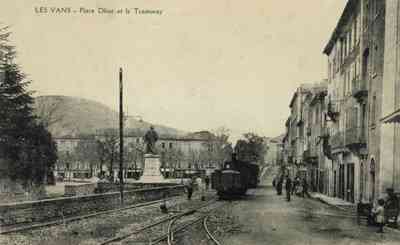 Turning left, you enter, between two large rocks, a small, lush ravine, and soon arrive at a tunneled rock at Gleizasse, in local dialect “the great church,” a cave or vestibule formed by two large inclined rocks with upper fissures that let in daylight: very interesting view of the left bank of the river. Then you see the Rotunda, a real dance hall, at a leveled plan.
Turning left, you enter, between two large rocks, a small, lush ravine, and soon arrive at a tunneled rock at Gleizasse, in local dialect “the great church,” a cave or vestibule formed by two large inclined rocks with upper fissures that let in daylight: very interesting view of the left bank of the river. Then you see the Rotunda, a real dance hall, at a leveled plan.
Beyond the castle of the Three Lords, where some shapeless ruins merge with the rock, you reach the wildest part of the forest, the Gagniet Woods district. It’s a vast maze of stone, wooded, covered with vegetation and brambles, where the rocks take on the most strange shapes.
One of the most beautiful sites is called the “Salon”: there, on shaded lawns beneath magnificent trees, rise large monolithic rocks, such as Lot’s Daughter, the Nun, etc. In the wall of a gigantic block, surrounded by brambles, a slit opens serving as a niche for a Virgin statuette, only visible when you approach almost to the foot of the rock. Not far away, in a small enclosure of rocks, a spring gushes from a fissure in a large stone.
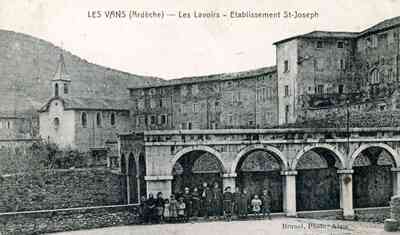 Returning towards the Mège Valley, you can visit the Creux de la Perdrix, located a few minutes off the road, as well as the Cave of L’Assiette. Conversely, if you continue through the forest southeastward, you reach the region of the dolmens: beyond the Rages Forest, the rocks gradually become shorter, the trees thinner; bushes follow, and you enter a desert of white stones inhabited by dolmens. You would thus arrive at Berrias, 10 km from Les Vans, but only 3 km from Berrias to Route N. 101.
Returning towards the Mège Valley, you can visit the Creux de la Perdrix, located a few minutes off the road, as well as the Cave of L’Assiette. Conversely, if you continue through the forest southeastward, you reach the region of the dolmens: beyond the Rages Forest, the rocks gradually become shorter, the trees thinner; bushes follow, and you enter a desert of white stones inhabited by dolmens. You would thus arrive at Berrias, 10 km from Les Vans, but only 3 km from Berrias to Route N. 101.
 Variant from Les Vans to Vîtlefort via the Borne road (27 km, only 3 km longer, very scenic but narrow and quite difficult; check the road condition before setting out). Initially, follow the direct route to Mende for 1.5 km, passing the curious group of 15 rosary reliefs. Then turn right, after the hamlet of Armes-Bas, cross a ravine and climb again. Gravel paths: Romanesque church containing a sculpted Tree of Jesse from the 14th century. Gravel bridge (170 m) crossing the Chassezac where it emerges from the gorges. Leave a small local road on the right, which follows a wild ravine where a small tributary of the Chassezac flows, leading to (10 km) Thines.
Variant from Les Vans to Vîtlefort via the Borne road (27 km, only 3 km longer, very scenic but narrow and quite difficult; check the road condition before setting out). Initially, follow the direct route to Mende for 1.5 km, passing the curious group of 15 rosary reliefs. Then turn right, after the hamlet of Armes-Bas, cross a ravine and climb again. Gravel paths: Romanesque church containing a sculpted Tree of Jesse from the 14th century. Gravel bridge (170 m) crossing the Chassezac where it emerges from the gorges. Leave a small local road on the right, which follows a wild ravine where a small tributary of the Chassezac flows, leading to (10 km) Thines.
Thines, 181 inhabitants, a poor village built on a steep pinnacle (542 m high), in a wild and magnificent site, preserves a Romanesque church that is among the most interesting in the Vivarais and nevertheless relates to the architecture of the Velay. Likely built in the first quarter of the 12th century, it is a granite structure consisting of only a vaulted nave and a semi-circular apse, the latter remarkable for its polychrome masonry and the elegance of its external decoration. The sculpture on the south side portal, from the last quarter of the 12th century (after 1175), resembles, according to Mr. Paul Deschamps, the major Provençal ensembles of Saint-Gilles and Saint-Bernard de Romans; the lintel depicts the Entry of Christ into Jerusalem, the Scene of Judas’ Kiss, and the tympanum dates only from 1862. The church houses a wooden Virgin from the 13th century, seated on a throne and holding the Child on her knees. A monument was erected in the hamlet of Tastevin in memory of twelve résistants, a peasant, and an elderly woman shot here by Germans on August 4, 1943.
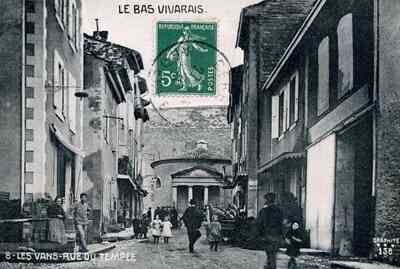 Lafigère, on the right on the hilltop. The road from Villefort climbs the valley, which gradually changes; shales give way to granites. Following northwest along the left bank, it traces all the bends of the Chassezac torrent. Sainte-Marguerite-Lafigère: magnificent view of the Pied-de-Borne site; in the valley, a factory processes lead-silver ore, copper, etc., from the Chassezac concession. Crossing the Borne, a left tributary of the Chassezac, via a beautiful bridge (border of Ardèche and Lozère), opposite the picturesque Sainte-Marguerite chapel, then descending the right bank of the Borne. On the left, perched on the mountain slope, are the hamlets of Planchamp, with the beautiful castle where Odilon Barrot (1791-1873) was born.
Lafigère, on the right on the hilltop. The road from Villefort climbs the valley, which gradually changes; shales give way to granites. Following northwest along the left bank, it traces all the bends of the Chassezac torrent. Sainte-Marguerite-Lafigère: magnificent view of the Pied-de-Borne site; in the valley, a factory processes lead-silver ore, copper, etc., from the Chassezac concession. Crossing the Borne, a left tributary of the Chassezac, via a beautiful bridge (border of Ardèche and Lozère), opposite the picturesque Sainte-Marguerite chapel, then descending the right bank of the Borne. On the left, perched on the mountain slope, are the hamlets of Planchamp, with the beautiful castle where Odilon Barrot (1791-1873) was born.
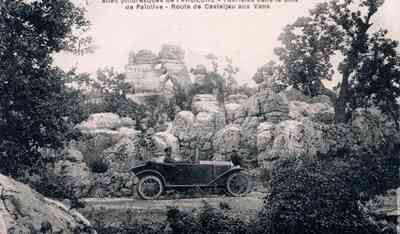 Pied-de-Borne, a hamlet accessible via a beautiful bridge over the Chassezac, in an incredible site at the foot of the Planchamp mountain and at the confluence of the three wild gorges of the Chassezac, the Altier, and the Borne.
Pied-de-Borne, a hamlet accessible via a beautiful bridge over the Chassezac, in an incredible site at the foot of the Planchamp mountain and at the confluence of the three wild gorges of the Chassezac, the Altier, and the Borne.
Borne is a natural region that includes not only the Borne valley, but also the upper parts of the Altier and Chassezac with their numerous secondary gorges; this granitic region, in its upper part, is more deeply scarred, wilder, and more beautiful than most of the Cévennes. The mountain dwellers have built terraced farms and vineyards on the slopes, and laid out small channels or "bégals" to bring water for irrigating. Beautiful chestnut groves cover the steep rocky slopes, and further down, there's olive trees and green oaks.
The road gently ascends the right bank of the Altier at the bottom of a magnificent gorge filled with chestnut trees, then leaves the Altier on the left to follow the right bank of the Palhères torrent.
From Les Vans to Vilefort, the N. 101 route is magnificent. After leaving Les Vans, it quickly climbs through the chestnut trees, via a steep, winding ramp, dominated on the left by the rugged slopes of Mount Malons (997 m) and on the right by the Chassezac valley: extensive views. The Col du Mas de l’Air (850 m), from where the road descends quickly and winding into the upper Céze valley. It then joins route N. 106, which is followed to the right to cross the small pass of Villefort (655 m), situated between the sources of the Céze and the valley of Palhères. by Jean Jacques Fauvel. Cévennes, Languedoc: Rouergue, Albigensian, Causses, Gévaudan, Velay, Vivarais
Former holiday hotel with a garden along the Allier, L'Etoile Guest House is located in La Bastide-Puylaurent between Lozere, Ardeche, and the Cevennes in the mountains of Southern France. At the crossroads of GR®7, GR®70 Stevenson Path, GR®72, GR®700 Regordane Way, GR®470 Allier River springs and gorges, GRP® Cevenol, Ardechoise Mountains, Margeride. Numerous loop trails for hiking and one-day biking excursions. Ideal for a relaxing and hiking getaway.
Copyright©etoile.fr